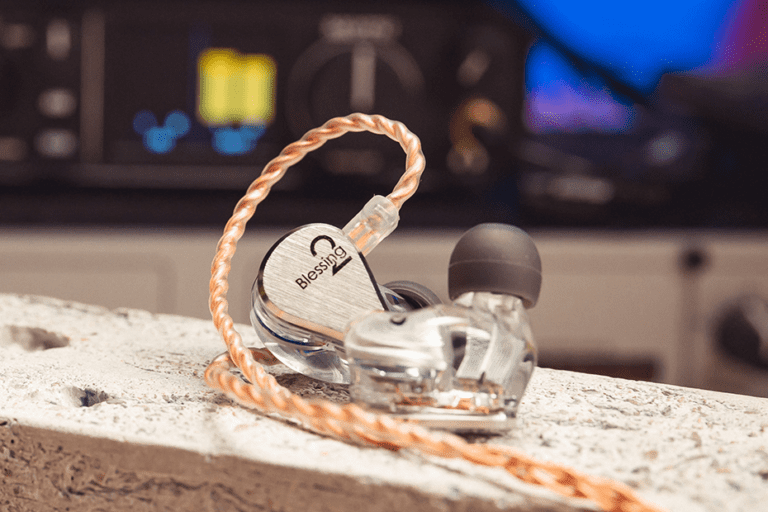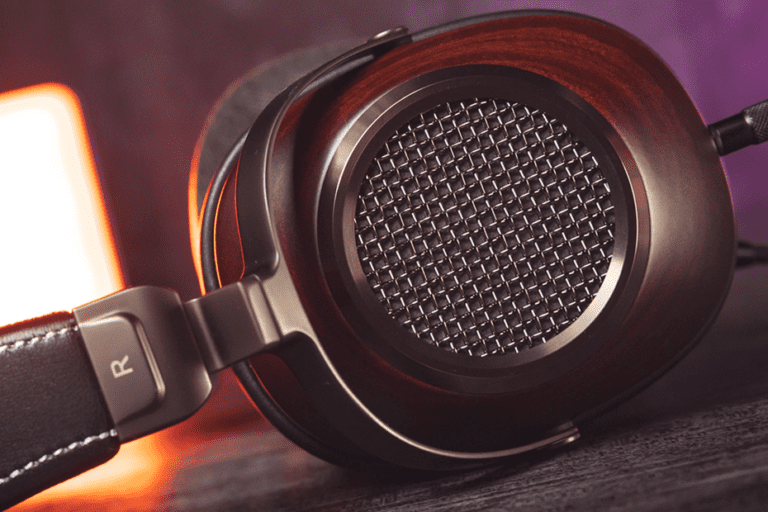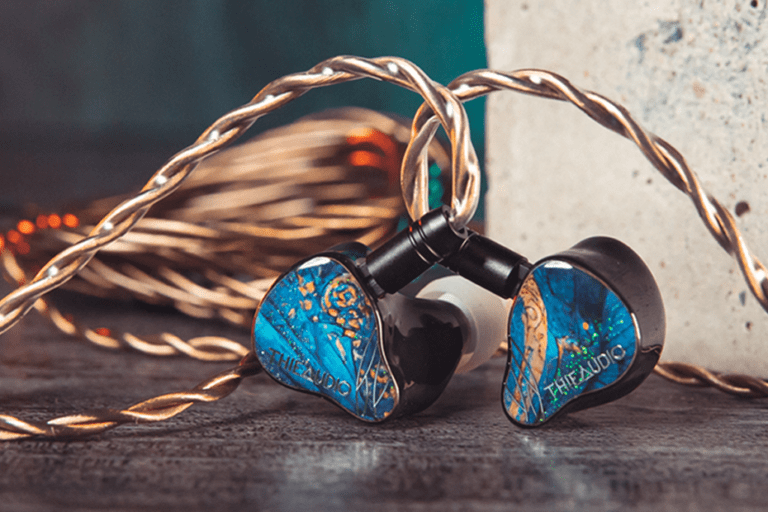Hello, I’m Alexander, and today we will talk about Moondrop Blessing 2 hybrid in-ear monitors and my 1-year long experience with this pair. This is the pair that I bought with my own money. No one paid me to make this review. I don’t offer any specific opinion and all thoughts expressed in this review are my own.
Moondrop is a well-known company to people in the headphone hobby, and the Blessing 2 and Blessing 2: DUSK are quite iconic. The IEM features 1 dynamic driver and 4 balanced armatures, resin shells with face plates made out of steel, and de-attachable cable. But we will start with unboxing.
The Blessing2 comes in a medium-sized box with a sleeve. There is yet another Waifu on the front sleeve and a list of technical specifications on the back of the sleeve. But I lost the sleeve, so no more Waifu for me. Inside the sleeve, there is a gray box.
In the box:
Design & build
The shells of Blessing2 have two parts that are glued together. The shell itself is made from a medical-grade transparent resin. And the faceplate, which is made from CNC-machined steel. The left face plate is clean and the right face plate has the model name engraving.
There have also been a few variations of the face plates and in addition at some point, Moondrop was offering a custom engraving too. Yet, I like the default design the most.
The shells are quite large and hefty. The shell has a slightly longer and thick nozzle with no mesh at the end. Instead, there are three sound bores present. The nozzle diameter is 6 mm. As there is no mesh at the end of the nozzle, you need to be careful and clean your ear tips regularly.
At some point, based on the community feedback regarding the absence of protective mesh, the Moondrop put up for sale a set of filters. You could buy this set and glue the filter to the end of the nozzle yourself. I didn’t bother with the filter kit, as I don’t think gluing a filter at the end of the nozzle could substitute the metal mesh. And in addition, the absence of the metal mesh didn’t bother me.
The shells have 1 vent hole which is located on the narrow part of the faceplate and I think this was a smart solution as it blends with the face plate design well. The IEMs use 2-pin connectors that are conveniently located on top of the IEM. Overall I like the build and design, and I think steel face plates look gorgeous with the transparent shells.
Cable
The cable that comes with this IEM is pretty basic and it can’t hold a candle to the IEM. It’s 1.2 meters long with plastic connectors on both ends, an alloy splitter, and no chin slider. The cable feels cheap, is a bit microphonic, and is very prone to tangling. This is a $320 IEM and I think it a shame to include such cable in the package. So that’s why I strongly recommend changing the stock cable. I went with a Tripowin Zonie 16 Core Silver Plated Cable.
Fit & comfort
Talking about fit & comfort, it’s where Blessing2 shines in my case. The fit & comfort of an IEM is still a very subjective thing. But I’ve tested dozens of IEMs in the last few years and finally concluded that to achieve a good fit & seal in my ears, the IEM should have long nozzles. And this is exactly the case with Blessing2.
When I received this pair, I was able to instantly secure a good fit & seal with the stock ear tips. In my case the fit & comfort is outstanding and the Blessing2 feels more like a semi-custom IEM in my ears, rather than an IEM with a generic fit. In addition, it provides a fantastic passive sound isolation in my case, which helps me to keep the volume lower than with some other my IEMs.
Blessing2 is quite hefty, but the weight is evenly distributed so I’m experiencing no discomfort even during long listening sessions. But the large shell size and long thick nozzle might not suit everyone’s ears.
Moondrop Blessing 2 sound impressions
As always, all sound impressions on my channel are completely subjective. You should take them with a grain of salt.
Blessing2 has both low impedance and high sensitivity and as a result, you can drive it with ease with many portable sources. My phone is usually my first go-to device when I start the IEM evaluation and it had no problems providing enough power to drive Blessing2. Pairing this IEM with better sources might provide sound quality improvement and make this pair shine, as it scales quite well.
Blessing2 has a linear bass which a lot of people will appreciate. What I like about the bass here is the fact it’s got a good body, speed, and impact. The sub-bass and mid-bass are almost equal in quantity with no clear separation between them. While some other models on the market aim for the prominent sub-bass and more neutral mid-bass, I like the Blessing2 approach much better. The bass is not bloated and has a good amount of details. Another good aspect is that there is no bass bleed into mids, so even on bottom-end heavy tracks the bass doesn’t overwhelm the midrange. In addition, the bass here is tangible and I can feel the displaced air and this is something that a lot of IEMs on the market don’t have.
The Blessing2 midrange is linear but is still a bit recessed to a certain degree so it occasionally takes a back seat. The timbre is accurate, and there is enough clarity and energy, but it is still a bit in the background. I found the midrange very enjoyable, and both instruments and vocals sounded correct to me. However, I need to admit that sometimes the mid-range feels distant and also there was a very rare upper mid-range glare on some recordings. The electric guitars sound good though and the vocals sound clear, rich, and full. While Blessing2 is not as mid-centric IEM as I’d like it to be, the midrange sounds very natural to me and has excellent clarity. It excels with many genres of music, and it especially shines with instrumental music.
The treble of Blessing2 is surprisingly detailed and energetic. While it lacks some air, it reveals many details and nuances in the recordings. At the same time, it’s quite linear and smooth. There are no harsh peaks here either. I would call the treble presentation open and in my case, it was never harsh or intrusive. However, if you are very sensitive to treble, it can still bother you a bit.
Sound stage and technical abilities
The Blessing2 soundstage is surprisingly large for an IEM and I was pleasantly surprised when I first tried it on. The sound stage feels more like the soundstage of a full-size pair of headphones. I’m not sure what’s exactly the magic here, but the sound stage is quite wide, deep, and tall as well. Instruments hold their particular places in space well, the soundstage never feels compressed or congested.
The imaging is excellent, the separation of instruments is great and the detail retrieval is good as well. You can easily identify what instruments are playing in the background and the whole presentation feels very coherent. As for detail retrieval, Blessing2 is still one of the best IEMs in the sub-$500 price bracket.
Blessing 2 vs Blessing 2: DUSK
Before getting Blessing2 I also compared it with Blessing2: DUSK. In my opinion, the DUSK edition, which is a collaboration between Crinacle and Moondrop will be more appealing to those, who need more bass and a slightly smoother upper mids. This translates into a more engaging and fun tuning.
I preferred the Blessing2, as to me it sounds more neutral, open, and detailed. In addition, when needed I can use a parametric EQ profile that brings my Blessing2 quite close to the Blessing2:Dusk.
Blessing 2 vs. Blessing 3
But what about Blessing3 you may ask? The newer is not always better. And this is my personal experience with Blessing3. First of all the configuration wise Blessing3 is different. It’s 2DD+4BA, as opposed to 1DD+4BA in the Blessing2. This means that we have a better cost per driver with Blessing3. But this also means a different tuning.
Blessing3 has a better treble extension which is more refined and detailed. But the mid-bass is leaner compared to Blessing2 and I didn’t like that. As a result, the sound profile of Blessing3 lies somewhere in between Blessing2 and Blessing2: DUSK. That being said, I prefer the sound profile of Blessing2.
If you already own Blessing2 or Blessing2:DUSK, I don’t see any reason for upgrading to Blessing3. Especially considering it’s more a side grade than an upgrade.
But if you have been saving to get Blessing2, I would consider giving all 3 models a listen first. This will help you determine which sound profile you like the most.
Blessing 3: DUSK?
At the time of making this review, the Blessing3: DUSK has yet to be announced, so all we have are rumors. What I would personally see in Blessing3:DUSK is a Blessing3 with a better mid-bass presentation that has more impact and authority.
What do I like about my Blessing 2?
What I don’t like?
Moondrop has released several very interesting and well-turned IEMs in the past years, yet I think none came close to the Blessing 2, besides maybe Variations. Though it offers a slightly different sound profile at a much higher cost.
I’ve been using my pair of Blessing2 for over a year now and I can understand why it gained such a massive following. Yes, it’s not cheap, but it brings a lot to the table for its price. And I still consider it among the best of IEMs that you can get under $500 in 2024.
I’m also having trouble upgrading from it, as no other IEM under $500 that I have tried so far sounded like an upgrade to me, both sound profile and comfort-wise, so I will stick to my Blessing2 for the time being.



